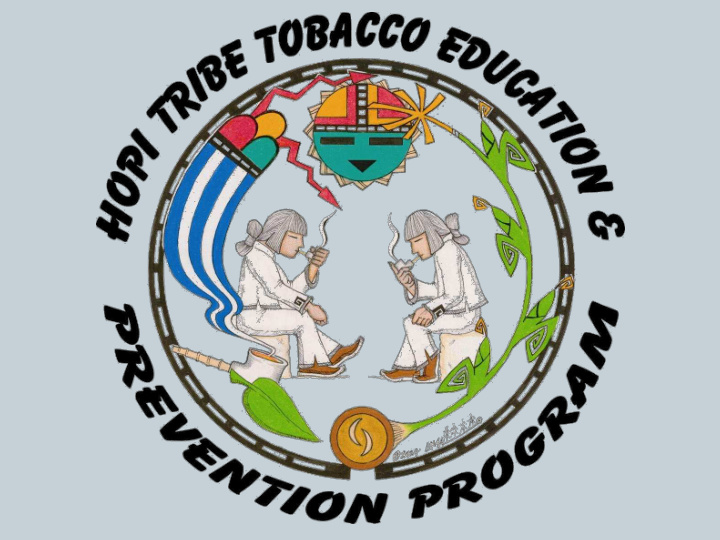



Tribal Collaborative Conference November 17 – 19, 2015 Flagstaff, Arizona ELDON KALEMSA JR. HOPI TOBACCO PROGRAM COORDINATOR “TRADITIONAL TOBACCO USE”
“Back in the saddle again”
Hopi Tobacco Mission Statement Mission : It is the mission of the Tobacco Program housed under the office of HOPI (Hopi Office of Prevention and Intervention) Cancer Support Services (HCSS) to provide responsive customer service in promoting education and prevention on commercial tobacco use among Hopi and surrounding native population while adhering to Hopi cultural beliefs and values to help promote a healthy lifestyle, disease prevention and support services to our Hopi and surrounding communities.
Vision and Philosophy VISION – “To instill personal responsibility through education and prevention with a traditional approach to create healthy families and communities while preserving the practicing Hopi culture and respect.” PHILOSOPHY - “In order to accomplish our mission and to fulfill our vision, we believe and are committed to supporting one another through coordination, communication and collaboration with all parties at all levels with respect to one another.
Hopi Tobacco Program Currently in the third year of a five year Inter- governmental Agreement (IGA) contract. Meaning now funded directly by Arizona Department of Health Services (ADHS). Previously funded through Inter-Tribal Council of Arizona (ITCA). Tobacco Program has been in existence since 1999. Previously focused on adult cessation services such as the Ashline but now the main priority is youth coalitions. As an integral partner of the Hopi Health Care Center we provide cessation services at HHCC and at the HCSS office.
Hopi Tobacco Program Resolution #H-180-87 This resolution designated that all Tribal buildings along with the Hopi Indian Health Service buildings be smoke-free. Adopted October 06, 1987 by the Council under the direction of Chairman Ivan Sidney. Resolution #H-068-2005 This resolution designates that all tribal buildings and IHS campuses be declared a 50 FT no-smoking zone. Adopted September 01, 2005 under the direction of Chairman Wayne Taylor Jr. The Hopi Tobacco Program continues to advocate to eliminate commercial tobacco use in our kivas and ceremonies.
Today Goals and objectives are geared more toward youth initiatives, youth coalitions and having youth be the educators and advocates for commercial tobacco prevention. Recruitment of youth to be coalition members. More youth led activities and still involved with National events such as World NO Tobacco Day, Kick Butts Week, Great American Smoke Out, and other State initiatives. Coalition involvement with local events and activities which includes the Hopi/Tewa Youth Council. Youth engage in policy initiatives (STAND).
Hopi High School Youth Tobacco Survey October 27, 2014 If yes then which: 1) Do you use tobacco products? Commercial 4 Yes 29 Traditional 13 No 151 Both 2 Not Specified 2 Not Specified 12 2) How often do you use tobacco products? Daily 1 Ceremonies only 17 3) Do you feel Traditional tobacco is sacred? Yes 154 No 27 Not Specified 1 4) Do you feel traditional tobacco is the same as commercial tobacco? Yes 24 No 155 Not Specified 3 5) Do you think we should eliminate (take out) commercial tobacco from our ceremonies? Yes 106 No 71 Not Specified 5
Hopi Youth Survey 2014 Do you feel traditional Do you think we should tobacco is sacred? eliminate (take out) 0% commercial tobacco from … 15% 3% Yes No Yes 39% No 85% Not Specified 58% Not Specified Do you feel traditional Do you believe smoking tobacco is the same as tobacco is bad for your commercial tobacco? health? 2% 13% 1% 4% Yes Yes No No Not Specified Not Specified 85% 95%
Wild Hopi Tobacco Plant
“Traditional Tobacco Use” Has been part of Hopi for a millennium of time. Annual use of traditional tobacco for ceremonies, events/ activities, and medicinal use. Preferably smoked in a clay or stone pipe. Age preference on use of traditional tobacco. Tobacco is not inhaled. Only the leaves are smoked, not the stems or roots. No additives. Not used continuously. Process of preparation applied. Tobacco clans. Sacred and respected (utiihi i ’ and kyaftsi)
Other Uses of Traditional Tobacco Medicinal uses: Relief for asthma patients Used as an ointment for: Burns Deep abrasions or cuts Analgesic paste for muscle relief (icy hot) Relief of ear aches Hunting/Gathering Gift/Payment
Today’s Health Disparities Integration of commercial tobacco into ceremonial practices. Commercial tobacco – addictive, recreational use. Asthma cases on the rise in Native populations. Youth and young adults are now introduced to electronic smoking devices such as e-cigs, vapors, e- cigars, e-hookahs, e-pens, etc. New tobacco products on the market. Marketing and technology
2012 Cancer Data
Current Cancer Data
Counteracts or Changes in Tobacco Use Youth coalitions. STAND initiative in State of Arizona (STANDaz.com) Outreach and education (peer to peer) method. Cessation services (traditional approach). Tribal /Legislative presence. Consult and recognition to traditional tobacco. Language and personalizing. Resources and partnerships.
2015 Winter Summit- Prescott, Arizona
Tobacco Coalition/HTYC with Senator Carlisle and Hopi Council delegate
Other Goals and Objectives Implement a traditional tobacco initiative within the grant. Possibly implement a traditional tobacco curriculum at the local Hopi High School with emphasis on traditional Hopi tobacco. Initiated discussions with National Forest Service, Bureau of Land Management (BLM), Coconino Forest Service and Parks to secure sites for traditional tobacco resources and gathering. Initiate youth projects with various entities to promote education (traditional and non-traditional) work profession exposure, implement youth activities and initiatives to support Hopi Tribal initiatives. Plans to propose for the “Spirit of Eagles” grant opportunity for construction of a green house.
Kwakwah! Päy yaasa á Uma häpi üng ká pas’ na oyeeyüngni. Nanami unängtaviyüngni, lolmat nikyäng pú haaläykyäkyäng üng ká yësni. This is all… You all take care of yourselves, keep up your well- being Live a happy and prosperous life.
Recommend
More recommend